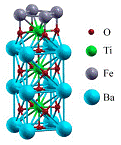Department of Physics and Astronomy: Publications and Other Research

Evgeny Tsymbal Publications
ORCID IDs
Tsymbal http://orcid.org/0000-0002-6728-5538
Paudel https://orcid.org/0000-0002-9952-9435
Document Type
Article
Date of this Version
6-18-2014
Citation
Scientific Reports (2014) 4: 5338
doi: 10.1038/srep05338
Abstract
Low dimensionality, broken symmetry and easily-modulated carrier concentrations provoke novel electronic phase emergence at oxide interfaces. However, the spatial extent of such reconstructions - i.e. the interfacial ‘‘depth’’ - remains unclear. Examining LaAlO3/SrTiO3 heterostructures at previously unexplored carrier densities n2D 14 cm-2 , we observe a Shubnikov-de Haas effect for small in-plane fields, characteristic of an anisotropic 3D Fermi surface with preferential dxz,yz orbital occupancy extending over at least 100 nm perpendicular to the interface. Quantum oscillations from the 3D Fermi surface of bulk doped SrTiO3 emerge simultaneously at higher n2D. We distinguish three areas in doped perovskite heterostructures: narrow (nm) 2D interfaces housing superconductivity and/or other emergent phases, electronically isotropic regions far (>120 nm) from the interface and new intermediate zones where interfacial proximity renormalises the electronic structure relative to the bulk.


Comments
Copyright 2014, Nature Publishing Group. Used by permission